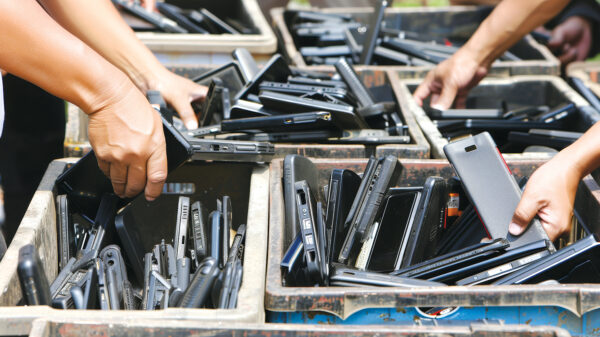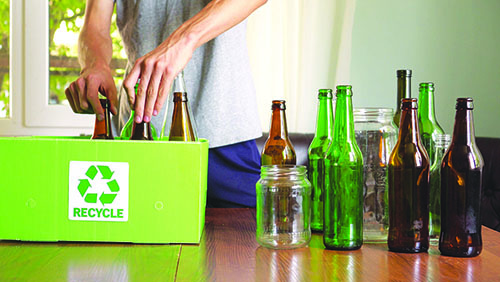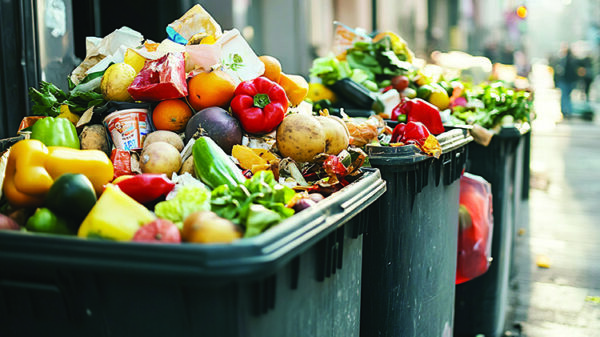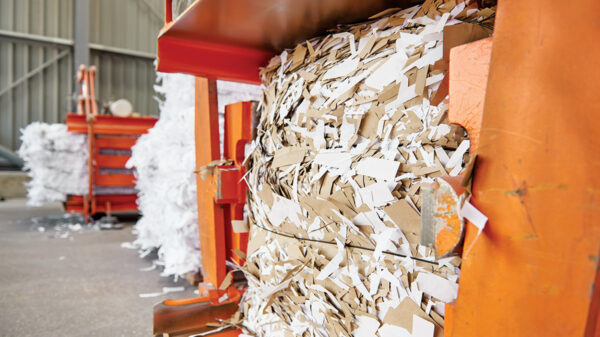A comprehensive report released by the Container Recycling Institute (CRI), a nonprofit recycling industry authority, shows that implementation of a national beverage container deposit return system (DRS, aka bottle bill) would result in the recycling of nearly 815,000 more tons of aluminum used beverage cans (UBCs). This would raise the national UBC recycling rate to 85 percent – an increase of 48 percentage points over the rate in 2021.
Titled “Improving Efficiency and Sustainability in Aluminum Beverage Can Recycling,” the report also finds:
- Improving existing state DRS programs with deficiencies would raise the national aluminum UBC recycling rate by 3.2 percentage points;
- Implementing DRS laws in all states that have introduced DRS legislation since 2021 would raise this rate by 20 percentage points; and
- Implementing DRS laws in the 10 non-deposit states with the highest populations would increase this rate by 24 percentage points.
The CRI report – made possible with support from the Arconic Foundation – is one of the first to address the issues involved in manufacturing aluminum beverage cans, and how these cans differ from other aluminum products. CRI prepared the report with RTI International by reviewing previous industry studies and conducting its own research, analyses and data compilation.
Aluminum Beverage Can Production, Use and Recycling: The Big Picture
In the U.S., aluminum UBCs are one of the most valuable types of consumer recyclables and have high potential for direct recyclability with limited losses. However, the report finds that current aluminum UBC recycling practices aren’t the end solution to limiting the laborious and energy-intensive extraction of bauxite ore, from which aluminum is made.
Given that recycling of aluminum saves more than 90 percent of the energy required to make the same amount of aluminum from virgin materials, the report indicates that “aluminum material losses at curbside recycling, materials recovery facilities (MRFs) and secondary melters are financially and environmentally significant enough to warrant discussion on new and expanded methods of aluminum beverage can recycling, sorting, processing and even design.”
Aluminum beverage can production nationally is at an all-time high, with nearly 110 billion units generated in 2022, and the U.S. consumes more than one-quarter of all the aluminum cans across the globe. However, the national aluminum UBC recycling rate has been trending downward over the last decade, and the 2021 rate of 37.2 percent (as calculated by CRI) is dramatically lower than that in many other industrialized countries.
CRI president Susan Collins said, “It is imperative that the domestic aluminum can industry improve its recycled content status, because the global aluminum can industry simply cannot meet its sustainability goals without such improvement. Also, additional material throughput is needed to support the multi-billion-dollar investments in two new secondary melters being built in the U.S., which will bring the total number of these facilities nationally to nine. Any further declines in the U.S. aluminum UBC recycling rate, or any legislative repeals of state DRS programs, would threaten UBC supply levels for the melters, putting a financial strain on their businesses.
“Data conclusively demonstrate that DRS programs are the most impactful way to increase UBC recycling rates,” Collins added, “and we believe that a potential 85 percent national recovery rate is achievable with a high performing, transparent recycling system.”
Losses Across the UBC Recycling Value Chain
Key findings from the report on aluminum beverage can losses across the value chain include:
- Lack of Collection: Just over half (55 percent) of aluminum UBCs in the U.S. are put in curbside bins or redeemed through a DRS (an option available in only 10 states). The remaining 45 percent are either trashed (and ultimately sent to a landfill or incinerated) or littered. If the country had only curbside recycling and no DRS programs, the theoretical maximum recycling rate would be 45 percent due to losses at MRFs and melters, as well as the fact that about 24 percent of beverages in aluminum cans are consumed away from home.
- Processing and baling at MRFs: A variety of state studies indicate that between 25 percent and 33 percent of aluminum beverage cans are missorted during the MRF sorting process, with one study putting the number at 53 percent. CRI is not aware of a national study on aluminum losses at MRFs. However, using a national 33 percent loss rate for single-stream MRFs and a reported 5 percent loss rate for dual-stream MRFs equates to more than 146,000 tons of UBCs being missorted in 2021. Additional comprehensive studies are needed to analyze the sorting and recovery accuracy of MRFs.
- Processing and baling at secondary melters: Secondary aluminum melters receive baled cans from DRS programs, MRFs (via scrap brokers), and drop-off sites and scrap yards. Eleven (11) percent of the total weight of incoming UBC bales from MRFs consists of contaminants that must be removed during processing. Contaminants include those that are unavoidable – inherent parts of the can and baling wire – and those that are avoidable – including PET and rigid plastics, dirt and debris, fiber and other materials.
Economic and Environmental Impacts
Losses and other deficiencies associated with current aluminum UBC recycling practices come with economic and environmental consequences, including:
•The economic value of the more than 1 million tons of wasted aluminum beverage cans in 2021 was approximately $1.6 billion.
•This represents a lost opportunity to reduce annual U.S. energy consumption by more than 160,000,000 million BTUs (based on the U.S. EPA WARM), which equates to the average annual energy consumption of approximately 2.1 million households.
•If these more than 1 million tons of wasted UBCs were recycled, potential greenhouse gas (GHG) emission reductions would total 9.8 million metric tons of carbon dioxide equivalent (also using the EPA’s WARM). This equates to the annual amount of GHG emissions from approximately 2.1 million passenger vehicles.
Strategies to Increase Aluminum UBC Redemption Rates
According to published data, 73 percent of U.S. households currently have access to either curbside recycling or drop-off programs. Thus, CRI’s Collins said, expansion of all types of recycling opportunities – including curbside, DRS and away-from-home recycling – and increased collaboration among the programs can ensure the highest aluminum UBC recovery rates.
However, she added, previous research, as well as analyses completed for the aluminum UBC report, conclusively demonstrate that DRS programs provide the most effective means to achieve meaningful recycling rate improvements.
Based on industry data, CRI calculated the U.S. recycling rate for aluminum beverage cans on deposit as 74 percent and the rate for cans not on deposit as 26 percent (2021 data). The 10 U.S. states with DRS programs account for almost half of the total tons of aluminum beverage cans recycled in the U.S. – 300,716 of the 633,500 tons total (2021 data).
DRS programs recycle greater numbers of UBCs because beverage cans on deposit are handled and sorted differently than those in curbside systems. Cans are kept as separate commodities throughout the DRS process, meaning they are not mixed with other materials, resulting in clean, high-quality UBCs more likely to be made into new containers.
Given the report analyses and data, CRI identified four strategies to improve the U.S. aluminum UBC recycling rate:
1. Improve existing state DRS programs that are deficient
Modernizing the 10 existing state DRS programs to include more beverage types and increase the deposit incentive from 5 cents to 10 cents is the simplest way to increase the national aluminum UBC recycling rate. States with DRS programs are in a unique position because redemption infrastructure already is in place; however, expanding availability of convenient beverage container redemption sites is important in states that have seen large numbers of center closures. Several DRS states have shown that modernization is a key element in increasing and maintaining consistently high recycling rates.
Implementing this strategy would result in the recycling of 54,007 more tons of aluminum beverage cans per year (in addition to the 633,500 tons currently recycled), which would increase the national UBC recycling rate by 3.2 percentage points.
2. Implement deposit laws in all states that have introduced DRS legislation since 2021
These states are Texas, Florida, Pennsylvania, Illinois, North Carolina, New Jersey, Washington, Maryland, New Hampshire and Rhode Island. Implementing this strategy would result in the recycling of 339,145 more tons of aluminum beverage cans per year, which would increase the national UBC recycling rate by 20 percentage points.
This amount of additional recycling would eliminate up to 3.1 million tons of GHG emissions annually, equivalent to taking nearly 675,000 cars off the road.
It also would eliminate up to 51.7 trillion BTUs of energy use, which is enough to meet the total residential energy needs of more than 670,000 American homes – or more than the total number of occupied housing units in the cities of Tampa, Fla. and Denver, Colo. combined.
3. Implement DRS laws in the 10 non-deposit states with the highest populations
These states are Texas, Florida, Pennsylvania, Illinois, Ohio, Georgia, North Carolina, New Jersey, Virginia and Washington. Implementing this strategy would result in the recycling of 412,475 more tons of aluminum beverage cans per year, which would increase the national UBC recycling rate by 24 percentage points.
This amount of additional recycling would eliminate up to 3.8 million metric tons of GHG emissions annually, equivalent to taking approximately 820,000 cars off the road.
4. Implement a national beverage container deposit return system
Implementing this strategy would result in the recycling of 814,545 more tons of aluminum cans per year, which would increase the national UBC recycling rate by 48 percentage points – to 85 percent. Key benefits associated with a nationwide DRS would include:
- Reducing landfill waste and litter: Nationwide in 2021, it was estimated that over 1 million tons of aluminum beverage cans ended up in landfills and incinerators or were littered instead of being diverted into a recycling system. This amount of wasted aluminum on its own could be used to rebuild the entire 2021 U.S. fleet of commercial aircraft 17.3 times over, totaling more than 109,000 mid- and large-sized planes.
- Reducing energy consumption: In 2021, 67 billion aluminum cans were wasted nationwide. Replacing these with new cans made from virgin materials consumed the energy equivalent of 124 trillion BTUs, which is enough to meet the total residential energy needs of 1.6 million American homes, or more than the total number of occupied housing units in the city of Chicago.
Collins said that implementation of a full DRS program in the U.S. would be challenging if not taken in stages. No country this large has ever implemented a new DRS program all at once.
She added, “However, based on our findings we can conclusively report that DRS programs are the ‘gold standard’ for beverage container recycling. New and improved programs are key to improvements that benefit industry, consumers and the environment.”
Published February 2025







